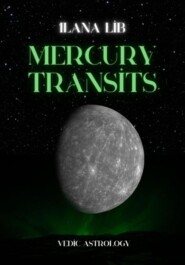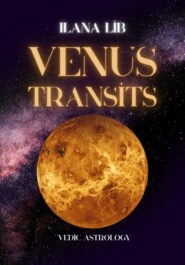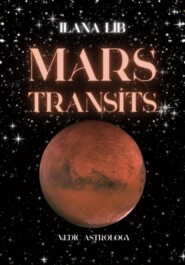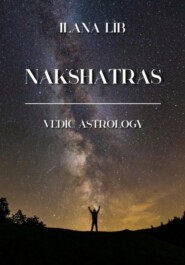По всем вопросам обращайтесь на: info@litportal.ru
(©) 2003-2025.
✖
The art of Jyotish: secrets unlocked
Настройки чтения
Размер шрифта
Высота строк
Поля
The art of Jyotish: secrets unlocked
Илана Либ
Jyotish (Indian or Vedic astrology) helps to make our life happier, more conscious, to understand our purpose and calling. Jyotish in translation from Sanskrit (the literary language of Ancient India) means Divine Light.
Илана Либ
The art of Jyotish: secrets unlocked
Preface
Many wonder why those who commit evil deeds often don’t face consequences, while good people may suffer unjustly. But the laws of karma are not that simple. No good or bad deed goes without consequences.
Types of Karma
There are four types of karma: Sanchita Karma, Prarabdha Karma, Kriyamana Karma, and Agami Karma (Vartamana Karma).
Sanchita Karma
This is the reservoir of all karma a person has (including all incarnations). It clears if the person engages in personal development, and as long as there is something to correct, they will be born again and again. If the person does not grow spiritually, the debts, sins, deeds, idleness, wrong thoughts, and everything they didn’t understand accumulate in the Sanchita Karma.
Prarabdha Karma
This is the karma to be corrected in this life (only in this life, which essentially constitutes the results of the soul’s many incarnations). Prarabdha Karma is usually very harsh. It cannot be avoided. The Vedic horoscope is the reflection of Prarabdha Karma. This karma predetermines certain events in life and longevity.
Kriyamana Karma
This is karma that operates quickly, these are the results of actions in the current life. But sometimes it happens that a person did something now and will only pay for it in the next life (Agami Karma).
Agami Karma
This is karma that can be changed after understanding an action, any act or non-action.
Jyotish is divided into three main parts: Ganita, Samhita, and Hora.
Ganita
Ganita – Astrological observation (astronomy). Earlier, when there were no computers, texts were used to describe the movement of the planets for the next 5 years. Nowadays, computers calculate everything. Ganita is divided into two parts: one is Ganita and the other is Gola.
Gola
Gola emphasizes philosophical observation related to the movement of planets. Observing the position of a certain planet and what phenomena are occurring in the sky at that time. Nowadays, astrologers no longer deal with this. It is the job of astronomers.
Samhita
This part of astrology is responsible for laws and regulations. These are laws for conducting religious rituals, for example. Samhita answers the question of what to do when a certain event occurs in a person’s life.
Hora
This part of astrology is used by astrologers. Today, they don’t deal with Ganita and Samhita. Hora is divided into four parts: Jatana, Nimita, Prashna, Muhurta.
Jatana
Jatana deals with the birth chart, the combinations of planets, everything related to a person’s horoscope.
Nimita
This is predictive astrology, based on diagnosing and predicting events according to signs (body signs, natural phenomena, based on the behavior of animals, birds, unusual situations, surprising encounters). This part of astrology is not particularly researched, but it works in extraordinary ways. It includes various signs carrying subtext and signals of karma. But it is important to pay attention to them. Dreams are also related to Nimita.
Here, I will give some examples. The first story is related to the famous ship, Admiral Nakhimov. Someone I know bought a ticket for a cruise for her daughter. Three days before the cruise, the ticket disappeared, although it was always in plain sight in the closet. Then a new ticket was purchased. Obviously, everything ended in tragedy.
The second story is related to starting a job that brought much suffering and a spine disease. The girl went through the job interview, was accepted, and was supposed to start the next day. That very night, she felt ill. It turned out she contracted rubella and started working only after two weeks. The illness was a good warning that she shouldn’t have taken that job.
Here’s another story about a new job. This person, before starting his new job, dreamed of all his deceased relatives. They stood together and judged him with their looks. In that job, he experienced unrequited love and many humiliating situations. It took him a long time to recover.
A beautiful white dove appeared in the stairwell of my friend’s house a month before she met her future husband. What was surprising was that the dove appeared in such a place. Such doves are usually seen in circuses, specially bred. The beautiful plumage looked like a fancy costume. But the dove had a problem with its leg. The children kept it at home and cared for it until it healed. Shortly after, the friend got married, but the marriage was very difficult, with many significant problems.
Prashna
This is a special method where a horoscope for an event is calculated in order to answer a question related to a specific event. In this case, the client’s birth chart is not used. According to certain rules, it is diagnosed whether the event will be delayed or not. There can be a yes or no answer to the asked question. It is also possible to receive an answer when someone wants to know if a specific person is alive. This method helps to see the investigated event very clearly.
Muhurta
Muhurta is used to diagnose whether a certain time is auspicious for starting something. It can be the purchase of a car, a house, a wedding, etc.
Today, personal charts – main and divisional charts – can be calculated using professional websites. It is enough to search for:
Free Astrology, Vedic Horoscope by date of birth and time.
After entering personal details, the charts will appear after clicking the title:
Lagna, Navamsha charts.
Characteristics of houses in the horoscope and their rulers
All houses in the Vedic horoscope are divided into groups. The houses belonging to the same group affect each other.
Kendra (houses: 1, 4, 7, 10) – These houses are considered the main and the foundation of the horoscope. It is easier to overcome difficulties with a strong foundation. These houses are considered the houses of the god Vishnu. Therefore, it is preferable for benefic planets to be in these houses to strengthen the foundation.
Trikona (houses: 1, 5, 9) – The most auspicious houses, they are called the houses of Lakshmi. The goddess Lakshmi brings us only success and prosperity. Therefore, it would be very good if benefic planets are in these houses.
Dusthana (houses: 3, 6, 8, 12) – These are unfavorable houses, and their characteristics speak for themselves: diseases, enemies, death, loss. Although the third house's characteristics are not clearly associated with something negative, it is considered the least 'Dusthana' house.
Maraka (houses: 2, 7) – These houses are traditionally called the houses of death because they relate to everything that can shorten a person's life.
Upachaya (houses: 3, 6, 10, 11) – These are houses of growth. These houses are considered good for malefic planets because as the person matures, these houses gain a lot of strength. Even malefics like Saturn and Mars can soften their negative effects.
House Lords
In order to determine the lord of a house, you must check which sign the house is in to know which planet rules it.
Илана Либ
Jyotish (Indian or Vedic astrology) helps to make our life happier, more conscious, to understand our purpose and calling. Jyotish in translation from Sanskrit (the literary language of Ancient India) means Divine Light.
Илана Либ
The art of Jyotish: secrets unlocked
Preface
Many wonder why those who commit evil deeds often don’t face consequences, while good people may suffer unjustly. But the laws of karma are not that simple. No good or bad deed goes without consequences.
Types of Karma
There are four types of karma: Sanchita Karma, Prarabdha Karma, Kriyamana Karma, and Agami Karma (Vartamana Karma).
Sanchita Karma
This is the reservoir of all karma a person has (including all incarnations). It clears if the person engages in personal development, and as long as there is something to correct, they will be born again and again. If the person does not grow spiritually, the debts, sins, deeds, idleness, wrong thoughts, and everything they didn’t understand accumulate in the Sanchita Karma.
Prarabdha Karma
This is the karma to be corrected in this life (only in this life, which essentially constitutes the results of the soul’s many incarnations). Prarabdha Karma is usually very harsh. It cannot be avoided. The Vedic horoscope is the reflection of Prarabdha Karma. This karma predetermines certain events in life and longevity.
Kriyamana Karma
This is karma that operates quickly, these are the results of actions in the current life. But sometimes it happens that a person did something now and will only pay for it in the next life (Agami Karma).
Agami Karma
This is karma that can be changed after understanding an action, any act or non-action.
Jyotish is divided into three main parts: Ganita, Samhita, and Hora.
Ganita
Ganita – Astrological observation (astronomy). Earlier, when there were no computers, texts were used to describe the movement of the planets for the next 5 years. Nowadays, computers calculate everything. Ganita is divided into two parts: one is Ganita and the other is Gola.
Gola
Gola emphasizes philosophical observation related to the movement of planets. Observing the position of a certain planet and what phenomena are occurring in the sky at that time. Nowadays, astrologers no longer deal with this. It is the job of astronomers.
Samhita
This part of astrology is responsible for laws and regulations. These are laws for conducting religious rituals, for example. Samhita answers the question of what to do when a certain event occurs in a person’s life.
Hora
This part of astrology is used by astrologers. Today, they don’t deal with Ganita and Samhita. Hora is divided into four parts: Jatana, Nimita, Prashna, Muhurta.
Jatana
Jatana deals with the birth chart, the combinations of planets, everything related to a person’s horoscope.
Nimita
This is predictive astrology, based on diagnosing and predicting events according to signs (body signs, natural phenomena, based on the behavior of animals, birds, unusual situations, surprising encounters). This part of astrology is not particularly researched, but it works in extraordinary ways. It includes various signs carrying subtext and signals of karma. But it is important to pay attention to them. Dreams are also related to Nimita.
Here, I will give some examples. The first story is related to the famous ship, Admiral Nakhimov. Someone I know bought a ticket for a cruise for her daughter. Three days before the cruise, the ticket disappeared, although it was always in plain sight in the closet. Then a new ticket was purchased. Obviously, everything ended in tragedy.
The second story is related to starting a job that brought much suffering and a spine disease. The girl went through the job interview, was accepted, and was supposed to start the next day. That very night, she felt ill. It turned out she contracted rubella and started working only after two weeks. The illness was a good warning that she shouldn’t have taken that job.
Here’s another story about a new job. This person, before starting his new job, dreamed of all his deceased relatives. They stood together and judged him with their looks. In that job, he experienced unrequited love and many humiliating situations. It took him a long time to recover.
A beautiful white dove appeared in the stairwell of my friend’s house a month before she met her future husband. What was surprising was that the dove appeared in such a place. Such doves are usually seen in circuses, specially bred. The beautiful plumage looked like a fancy costume. But the dove had a problem with its leg. The children kept it at home and cared for it until it healed. Shortly after, the friend got married, but the marriage was very difficult, with many significant problems.
Prashna
This is a special method where a horoscope for an event is calculated in order to answer a question related to a specific event. In this case, the client’s birth chart is not used. According to certain rules, it is diagnosed whether the event will be delayed or not. There can be a yes or no answer to the asked question. It is also possible to receive an answer when someone wants to know if a specific person is alive. This method helps to see the investigated event very clearly.
Muhurta
Muhurta is used to diagnose whether a certain time is auspicious for starting something. It can be the purchase of a car, a house, a wedding, etc.
Today, personal charts – main and divisional charts – can be calculated using professional websites. It is enough to search for:
Free Astrology, Vedic Horoscope by date of birth and time.
After entering personal details, the charts will appear after clicking the title:
Lagna, Navamsha charts.
Characteristics of houses in the horoscope and their rulers
All houses in the Vedic horoscope are divided into groups. The houses belonging to the same group affect each other.
Kendra (houses: 1, 4, 7, 10) – These houses are considered the main and the foundation of the horoscope. It is easier to overcome difficulties with a strong foundation. These houses are considered the houses of the god Vishnu. Therefore, it is preferable for benefic planets to be in these houses to strengthen the foundation.
Trikona (houses: 1, 5, 9) – The most auspicious houses, they are called the houses of Lakshmi. The goddess Lakshmi brings us only success and prosperity. Therefore, it would be very good if benefic planets are in these houses.
Dusthana (houses: 3, 6, 8, 12) – These are unfavorable houses, and their characteristics speak for themselves: diseases, enemies, death, loss. Although the third house's characteristics are not clearly associated with something negative, it is considered the least 'Dusthana' house.
Maraka (houses: 2, 7) – These houses are traditionally called the houses of death because they relate to everything that can shorten a person's life.
Upachaya (houses: 3, 6, 10, 11) – These are houses of growth. These houses are considered good for malefic planets because as the person matures, these houses gain a lot of strength. Even malefics like Saturn and Mars can soften their negative effects.
House Lords
In order to determine the lord of a house, you must check which sign the house is in to know which planet rules it.

















